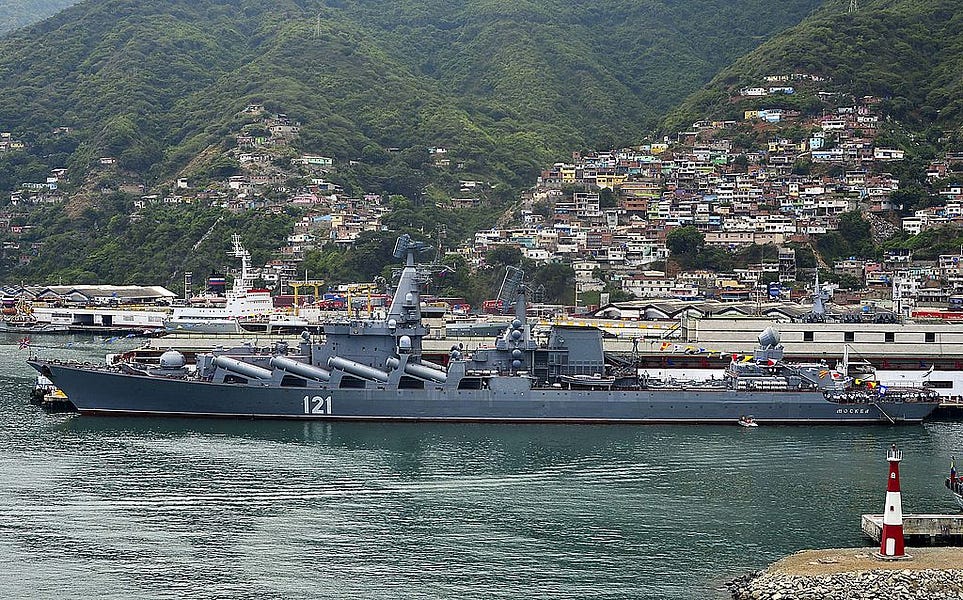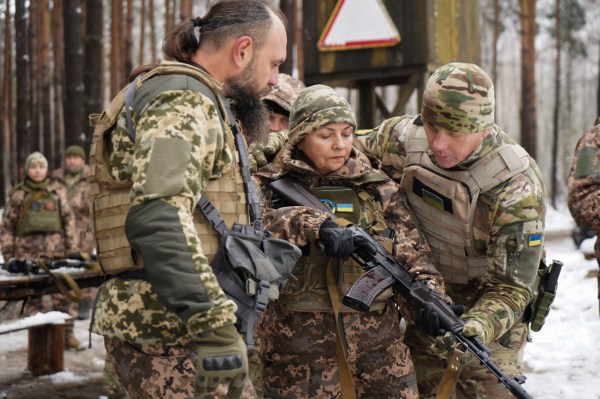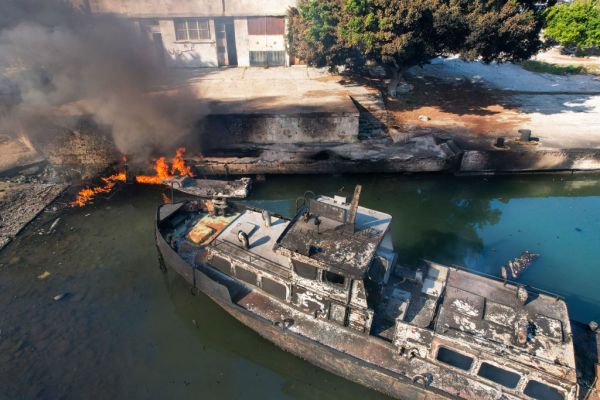Late last Wednesday night or early Thursday morning, two Ukrainian R-360 Neptune anti-ship missiles struck the Moskva, an Atlant-class cruiser that was the flagship of Russia’s Black Sea fleet. The ship eventually sank because of the damage. There are still numerous conflicting reports about exactly what happened: whether Ukraine distracted the Moskva with drones before attacking it with missiles, questions about how many of the crew died and the circumstances of the final sinking, etc. What is crystal clear is that the Moskva is at the bottom of the Black Sea, that the Ukrainians put it there, and therefore that Russia has suffered an embarrassing naval defeat against a country that, in effect, no longer has a fleet. The reaction of some Russian propagandists to the sinking also provides an interesting example of how they are increasingly blaming Russia’s military failures on NATO, rather than on Ukrainian resistance.
The significance of the sinking of the Moskva to the current fighting is mostly on the symbolism/morale front. The main armament of the Moskva were anti-ship missiles, which are not relevant while the Ukrainian navy is out of action. (The Ukrainian navy has lost at least one ship out on patrol, and the Ukrainian naval base at Odesa has probably been struck multiple times and destroyed their capabilities further. The Ukrainian ships that remain lack the weaponry to take on the Russian fleet.) The loss of the anti-aircraft/anti-missile capabilities of the Moskva might be a technical blow to the Russian Black Sea fleet (it carried an S-300 AA system), but its significance is unclear. (Any air defense systems it had were obviously not sufficient to defend the ship itself, or perhaps they were switched off.) According to retired Ukrainian naval Capt. Andrii Ryzhenko, the Russian Black Sea fleet has three main tasks: 1) blockade Ukrainian ports, 2) neutralize the Ukrainian navy, and 3) conduct a landing operation if needed. The Moskva is not needed to blockade Ukrainian ports, the Ukrainian fleet is unfortunately already ineffective as its remaining ships have inadequate armament to pose a serious threat to Russian ships, and a naval landing near Odesa would make sense only as part of the three-pronged attack from the Russian base in Transnistria (a Russian proxy enclave in Moldova), Mykolaiv, and the sea, something which does not appear to be in the cards as the Ukrainians have turned back the Russian assault on Mykolaiv.
The main thing the Russians lost was not any specific capability but their flagship, one that had already become internationally emblematic early in the war. On February 24, the first day of Putin’s expanded war, it was the Moskva that demanded the surrender of the Ukrainians defending Zmiinyi Island (aka Snake island). A Ukrainian defender delivered the memorable reply “Russian warship, go f— yourself.” The Moskva then opened fire with its twin 130mm deck guns and, with the help of at least one other Russian warship, forced the Ukrainian defenders to surrender. The incident became a famous symbol of Ukrainian resistance. Last week the Ukrainian postal service even issued a stamp depicting one of the Ukrainian defenders on Snake Island giving the Moskva the finger.
A photoshopped “updated” stamp showing the Moskva sinking is now floating around social media. Russian media are trying to contain the embarrassment and minimize the sense of disaster. Over the weekend the main Russian news show devoted just 30 seconds to the sinking. The TV channel of the Russian Ministry of Defense broadcast a video of an inspection of the crew of the Moskva by the commander. This video was probably partly motivated by a Russian desire to contradict reports of massive crew casualties and the death of the Moskva’s commander. Even so, the loss of a large ship with a crew of about 450 can’t just be ignored or dismissed. One prominent Russian propagandist, Vladimir Solovyov, expressed outrage at this disaster on his live show over the weekend:
“I’m furious about what happened to the flagship of the Black Sea Fleet—the Moskva … and we can say say, yes, she was many years old, yes, she was undergoing repairs, yes. Sure, this series of ships does have vulnerable places… I understand everything, can you just explain to me how you could lose it?”
It appears that the evolving Russian propaganda response to this catastrophe is not to deny that it happened, but to deny that it happened in the way it is described: The Ukrainians didn’t sink the Moskva; NATO sank the Moskva using Ukrainian proxies. As one Russian commentator put it, the Russian yellow press started disseminating the story that “the attack on the cruiser Moskva was a carefully planned joint action of the Armed Forces of Ukraine and Western countries. In addition to the Armed Forces of Ukraine, military specialists from Britain, Canada and Australia took part in it.”
This shift of “blame” for Russia’s failures from Ukraine to NATO and other Western allies (above all the United States) is becoming a standard explanation, not just for the destruction of the Moskva. If Russia is failing to destroy Ukraine, a country that Russian propagandists have called “fake,” after ridiculing its military and society and announcing its imminent doom for years, what does that tell you about the Russian military and state? However, if Russia is in fact fighting NATO in Ukraine, then of course one should expect reverses. NATO forces are the best in the world, and of course the Russian military is having trouble. Losing against Ukraine is unacceptable; losing against NATO is understandable. Top Russian propagandist Margarita Simonyan, the longtime editor in chief of RT, recently made this argument at length when discussing Russia’s battlefield failures:
We need to understand, when we see difficult events taking place, the losses, we need to understand that we are not fighting against Ukraine. Not at all! Not with Ukraine. And we are not just not fighting against Ukraine or Ukrainians from a moral and ethical point of view, but from an entirely technical, military point of view we are fighting with NATO! We are fighting against an enormous armed opponent, the most powerful and in essence the only one of its kind. In fact, not only the only one of its kind but the world’s only military organization with such power.
We are on our own fighting against all of them. Just think about that. Every time when somebody asks you why we have been there [Ukraine] for 45 days already, not 45 weeks or 45 months but 45 days… Not weeks even, not months, let alone years. ‘Look at how long we have been fighting Ukraine on its own!’ Well, first of all it’s Ukraine, Ukraine and not Georgia like in 2008, one could say. But that is not even the point. It is not Ukraine, it is NATO!
One can also see this desire to place as much blame as possible on NATO countries for Russia’s failures in the current fighting for Maripuol. This coastal city in southern Donetsk was probably supposed to fall rapidly at the start of the fighting, like other cities in Ukraine’s southeast. Instead Ukrainian defenders have endured over a month of grueling siege warfare. Today they have been pushed back to one or two pockets around an industrial plant in the city’s south. Some Russian media outlets have been spreading the idea (in the Russian language) that there are foreign fighters there, even that the French Foreign Legion is directly engaged in the fighting. Yes, that is the storied French Foreign Legion, not the “foreign legion” rapidly established by the Ukrainians to organize foreign volunteers. This story seems to have its origins in the supposed discovery in Mariupol of a green French beret with a French Foreign Legion pin. “Aha”, went some Russian messaging, “here is the reason that President Macron is so interested in peace in Ukraine, he is trying to prevent the capture of his French soldiers we have surrounded!” This kind of mythologizing can even give Russia some political victories while they are embarrassing themselves on the battlefield. One Russian military blog reported: “After the publication of information that French military personnel may be participating in the battles in Mariupol, the rating of French President Emmanuel Macron dropped by several points.”
This kind of messaging has its limits. If there were significant NATO forces and spies in Ukraine, enough to frustrate Russia’s plans, shouldn’t Putin and his spies have known about this and planned accordingly? (Solovyev made this argument during his rant about the loss of the Moskva.) This kind of messaging could also be used to pre-justify any activities Russia might take against NATO countries—sabotage in Europe, for example. As with any propaganda, there is always a danger that the leaders of a country spreading these stories either believe it or come to believe it as time goes on. The threat of an expanded war in Europe does not stem from giving Ukraine enough weapons to resist Russian attacks, but in crazy ideas from Russian disinformation actually affecting Russian behavior.






Please note that we at The Dispatch hold ourselves, our work, and our commenters to a higher standard than other places on the internet. We welcome comments that foster genuine debate or discussion—including comments critical of us or our work—but responses that include ad hominem attacks on fellow Dispatch members or are intended to stoke fear and anger may be moderated.
You are currently using a limited time guest pass and do not have access to commenting. Consider subscribing to join the conversation.
With your membership, you only have the ability to comment on The Morning Dispatch articles. Consider upgrading to join the conversation everywhere.